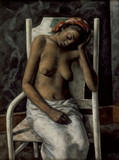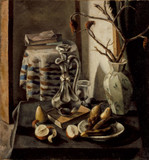Henry Lee McFee was an early modernist active in Woodstock, New York, and New York City who later introduced his avantgarde approach to a generation of Southern California artists. After studying art in Saint Louis and at the Stevenson Art School in Pittsburgh, he moved to Woodstock in 1908 to study landscape painting with Birge Harrison (1854-1929). In 1909 he began working independently, and through ANDREW DASBURG, who remained a lifelong friend, he was introduced to European modernism..
McFee studied the work of Georges Braque (1882-1963), Pablo Picasso (1881-1973), and Pierre-Auguste Renoir (18941974) as well as Italian Renaissance painters and the art theories of Clive Bell, Roger Fry, and Willard Huntington Wright. The work of Paul Cézanne (1839-1906), however, was the most significant influence on McFee’s development.
McFee was one of the leading members of the Woodstock colony’s modernist Rock City Group (which also included Dasburg, Konrad Cramer [1888-1963], and EUGENE SPEICHER). Although he first exhibited at the MacDowell Club in New York in 1912, it was not until 1916, when he participated in the landmark Forum Exhibition of Modern American Painters, that he showed more progressive cubist still lifes. Throughout his career still lifes predominated in his work, yet he never stopped painting landscapes. His landscapes of the 1920s are reminiscent of Picasso’s spare, geometric landscapes of 1907. Although he never abandoned his concern for plastic expression and the organization of color, in the mid-1920s McFee began to paint more traditionally with glazing techniques inspired by both old and modern masters. In the mid-1930s he produced a notable group of figure paintings of blacks.
Frank K. M. Rehn Galleries in New York held a series of solo exhibitions of McFee’s art beginning in 1927. Even so, in 1937 financial demands forced him to begin teaching frill time, for which he moved first to San Antonio, Texas, and Savannah, Georgia, and then in 1940 settled in Los Angeles. That year he was awarded a Guggenheim Fellowship. McFee became known as one of the important painters and foremost teachers in Southern California, inspiring an entire generation with his instruction in figure and still-life painting, first at Chouinard School of Art in Los Angeles and from 1943 at Scripps College in Claremont.
BIBLIOGRAPHY
Henry Lee McFee, "My Painting and Its Development," Creative Art 4 (March 1929): xxvii-xxxii § Virgil Barker, Henry Lee McFee, American Artists Series (New York: Whitney Museum of American Art, 1931), with biographical note, bibliography § Warren Wheelock, "Henry Lee McFee: Comments on the Man and His Painting," Art Instruction 2 (November 1938): 4-9 § Arthur Millier and Henry Lee McFee, Henry Lee McFee (Claremont, Calif.: Fine Arts Foundation of Scripps College, 1950), with biographical note, list of awards, bibliography § John Baker, Henry Lee McFee and Formalist Realism in American Still Life, 1923-1936, A Center Gallery Publication (Lewisburg, Pa., and London: Bucknell University Press and Associated University Presses, 1987), with bibliography, published in conjunction with an exhibition at the National Museum of American Art, Smithsonian Institution, Washington, D.C., and others, 1986-87.

